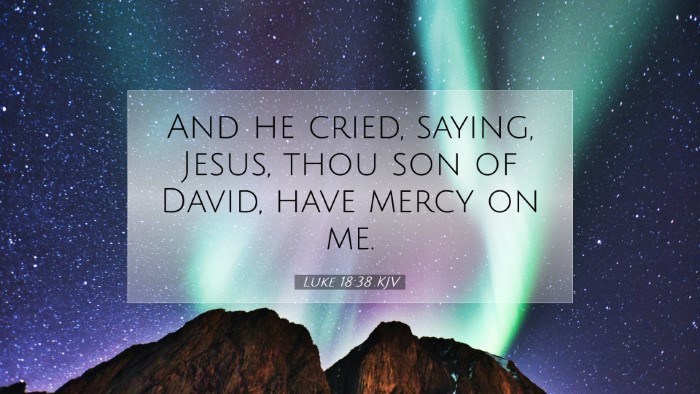Commentary on Luke 18:38
Luke 18:38 states, "And he cried, saying, Jesus, thou son of David, have mercy on me." This verse encapsulates both the desperation of the blind man and the recognition of Jesus's messianic identity. A thorough exploration of this verse provides great insights into its theological significance, the understanding of mercy, and the implications of faith.
Context and Background
This verse occurs within a narrative where Jesus is traveling through Jericho on His way to Jerusalem. The blind man, often referred to as Bartimaeus in parallel accounts, recognizes Jesus as the "Son of David," indicating his understanding of Jesus's royal lineage and messianic role.
Messianic Recognition
Matthew Henry notes that the title "Son of David" reflects the fulfillment of Old Testament prophecies concerning the coming Messiah. This acknowledgment of Jesus's lineage from David underlines the blind man's faith in Jesus's ability to heal and deliver. It is striking to observe that despite his physical blindness, he perceives spiritual truths that many with sight fail to recognize.
The Cry for Mercy
In his commentary, Albert Barnes emphasizes the plea for mercy, viewing it as a profound cry that encompasses humility and desperation. The blind man does not demand healing but beseeches Jesus for compassion. This illustrates a key aspect of prayer; it is often rooted in a recognition of one's need.
Moreover, Adam Clarke elaborates on the essence of mercy. He states that mercy is an essential attribute of God, where the act of reaching out conveys the heart of God towards humanity in distress. The blind man's plea serves as an example for believers, encouraging them to approach the Lord with their needs.
Theological Implications
This verse invites a broader reflection on themes such as faith, persistence, and divine compassion. The blind man—despite societal barriers and the crowd's rebuke—perseveres in his cry. His insistence serves as a paradigm of faith, showing that true faith may require perseverance in the face of discouragement.
Faith in Action
Henry points out that this blind man's faith spurred him to action. His declaration of Jesus as the "Son of David" was not merely verbal; it was infused with confidence. He believed that Jesus could heal him, and this faith prompted him to cry out for help. This contrasts starkly with many who witnessed Jesus's works but remained skeptical.
Overcoming Obstacles
Further, the crowd's response to the blind man's cries adds another layer of meaning. They attempted to silence him, illustrating the social obstacles that can hinder individuals from approaching Jesus. Barnes highlights this aspect, suggesting that the tenacity displayed by the blind man teaches believers the importance of not allowing external negative influences to diminish their faith.
Practical Applications for Believers
The narrative of Luke 18:38 has profound applications for pastors, students, and theologians alike. The themes of mercy, faith, and perseverance resonate deeply within the Christian experience.
- Encouragement to Seek Jesus: The unwavering faith of the blind man serves as a reminder to believers to actively seek Jesus in times of need.
- Understanding of Mercy: Reflect on the depth of God's mercy and extend this mercy to others, particularly those who are marginalized or in need.
- Persistence in Prayer: Emulate the blind man's persistent cries to God, learning that perseverance is often required to see breakthrough.
Conclusion
Luke 18:38 offers rich insights into the nature of faith and the character of Christ. By understanding the blind man's cry, believers are encouraged to confront their limitations, persist in their pleas, and anticipate the mercy and grace of Christ, who responds to those who seek Him with sincerity and faith. The interplay of desperation and faith in this passage not only enriches theological understanding but also inspires practical living in the pursuit of a deeper relationship with God.


